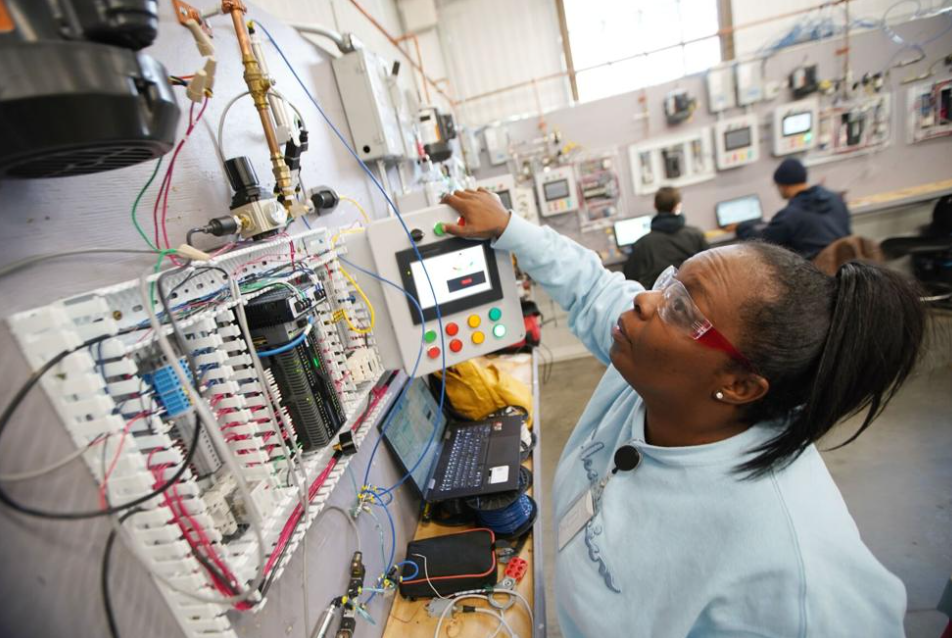
HOCHUL PROPOSES WORKFORCE TRAINING CENTERS TO BOOST MANUFACTURING USING NWTC AS MODEL
01.09.24
Story originally published January, 2024 via The Buffalo News
Gov. Kathy Hochul is proposing the creation of workforce development centers that would help the state meet a rising need for trained workers in advanced manufacturing.
Hochul, in her State of the State address on Tuesday will propose establishing One Network for Regional Advanced Manufacturing Partnerships, or ON-RAMP. The network would consist of workforce development centers in “strategic, high-impact locations in upstate New York, according to the governor’s office.
The centers would offer credentials and training related to advanced manufacturing and focus on providing opportunities for disadvantaged populations, the governor’s office said. The centers would focus on upstate regions.
Hochul’s plan calls for establishing four workforce development centers spanning upstate New York, along with a flagship facility in Syracuse overseen by CenterState CEO, an economic development organization. Three additional centers would be established in upstate New York on a competitive basis, particularly in the Capital region and along the I-90 corridor encompassing Buffalo, Rochester and Syracuse.
Hochul’s office said ON-RAMP is seeking to replicate the model of the Northland Workforce Training Center, which revitalized a vacant industrial building on Buffalo’s East Side with space for training programs.
The proposal would build on the “tech hub” designation a federal government agency recently awarded to the combined Buffalo, Rochester and Syracuse region. The three regions are jointly competing for up to $75 million in funding in the federal competition.
The governor’s proposed workforce centers also would help address an ongoing concern: supplying enough tech workers to meet current demand, let alone the demand expected to arise from big tech-related projects on the way.
Micron Technology plans to build a chip-making complex outside Syracuse with a potential total investment of $100 billion. Closer to home, Edwards Vacuum plans to invest $319 million in a plant in Genesee County to supply the semiconductor industry. Meanwhile, Advanced Micro Devices has established two upstate locations, one each in Monroe County and Dutchess County.
“With 21st-century businesses like Micron, Edwards Vacuum and AMD ready to make their home in upstate New York, ON-RAMP will be a critical tool to ensure that New Yorkers are trained with the skills they need to be part of New York’s manufacturing resurgence,” Hochul said in a statement. “This network of training centers along the I-90 tech Corridor will help to fill the jobs of tomorrow and build the next generation of high-skilled workers upstate.”
The Buffalo Niagara region hopes to benefit from a spinoff effect from those projects. The region has taken steps to increase its pool of manufacturing workers, through programs at Northland designed to meet employers’ immediate needs. And the newly formed Western New York Manufacturing and Tech Workforce Coalition is focusing on getting more workers trained.
But the Buffalo Niagara region’s tech sector remains undersized compared to other parts of the country. A recent Brookings report said the Buffalo Niagara region had just 0.2% of the nation’s jobs in key tech industries, from software development and computer systems design to web publishing. Rochester had the same, tiny percentage.
The joint bid by Buffalo, Rochester and Syracuse to be named a “tech hub” has put the three upstate regions in the hunt for a combined $75 million. Their combined effort – under the NY SMART I-Corridor Tech Hub banner – focuses on cultivating upstate New York’s semiconductor industry.
The tech hub designation put the 31 areas – out of nearly 250 other applicants – in the running to win federal funding through the tech hub program. But only five to 10 are expected to be awarded funding, as the federal government aims to promote innovation outside of hotbeds like the Silicon Valley.
In the first phase of the tech hub competition, applicants were asked to say why they deserved to be tech hubs, based on their assets. In the second phase, they are being asked to submit proposals for how they would put the funds to work, if awarded money.
The proposals are due by Feb. 29. The U.S. Economic Development Administration expects to announce the winners of the funding this summer.
Backers of the joint bid say securing $75 million would be a boost. But they also view the funds as akin to seed capital, kickstarting tech hub development plans that could also attract funding from the private, philanthropic sector and public entities.
